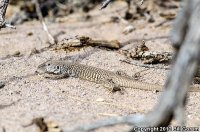| Range: |
 From the Continental Divide to the Guadalupe Mountains Escarpment. From the Continental Divide to the Guadalupe Mountains Escarpment. |
| Other Names: |
Marbled Whiptail |
| Description: |
Slender lizard with a comparatively long tail, almost 3 times the head-body length. Small, granular dorsal scales with enlarged scales in front of throat fold only. Dorsal ground color is gray. Dorsal pattern consists of 4-8 light stripes and a mottling of light and dark spots; there are alternating light and dark bars on the sides of the lizard. Pale peach coloration on throat and chest. Ventral surface white or pale yellow with possible black flecks on chin, throat, and chest. Tail gray or greenish gray with black flecks on sides and dark coloration on underside. Belly with 8 rows of large, rectangular scales. Aspidoscelis marmorata can grow to 20-30 cm (8-12 in). |
| Similar Species: |
The Common Checkered Whiptail and Gray Checkered Whiptail both differ in having abruptly enlarged mesoptychial scales, an immaculate ventral surface marred by at most a few black flecks, and a boldly reticulate dorsal pattern. Can be distinguished from its Eastern counterpart by range. |
| Venom: |
None |
| Habitat: |
Aspidoscelis marmorata prefers sandy areas with little vegetation and open woodlands in arid and semi-arid environments. |
| Behavior: |
This diurnal lizard forages for prey among vegetation clumps. This species is also extremely wary and will retreat to protective cover or dart into a burrow if approached. |
| Hibernation: |
Underground during cool months |
| Reproduction: |
Breeding takes place in April and May. Females lay 1-4 eggs in May. A second egg clutch may be laid in July. Hatchlings appear in July and August. Hatchlings with bright blue tail. |
| Diet: |
insects, spiders and scorpions |
Adapted from account on 








